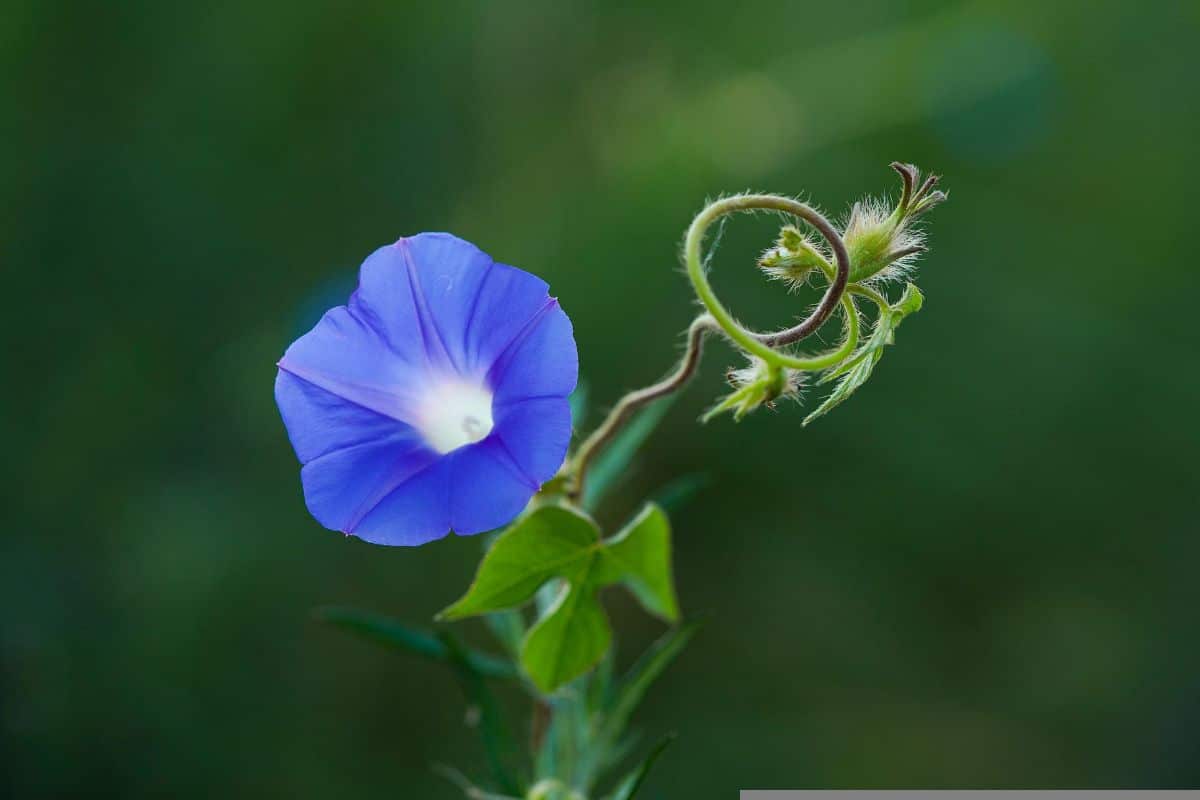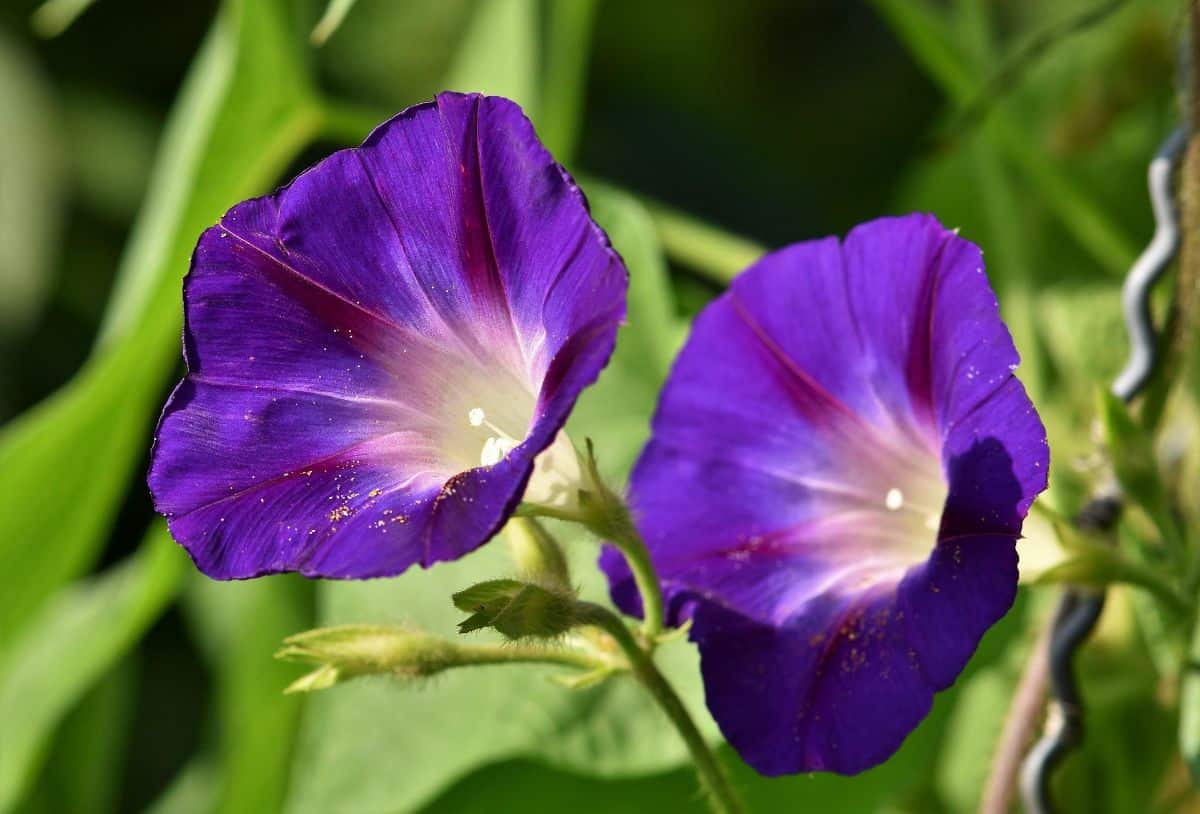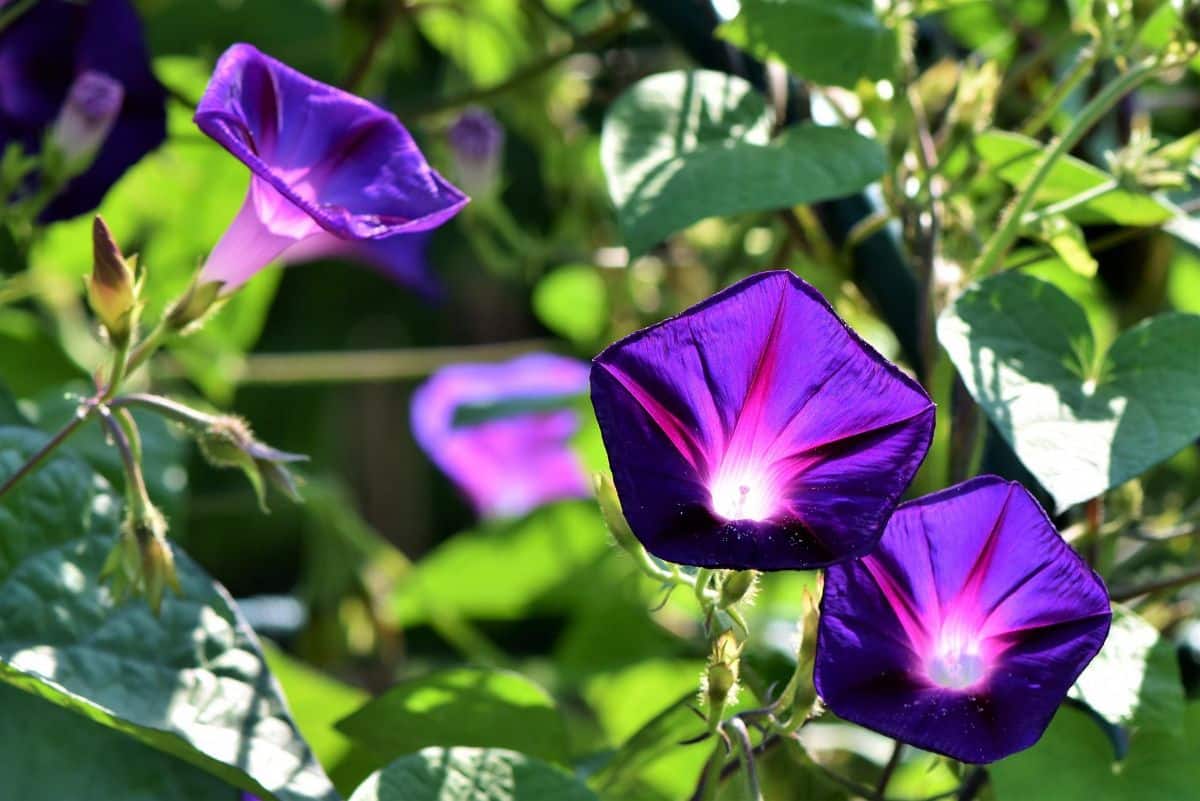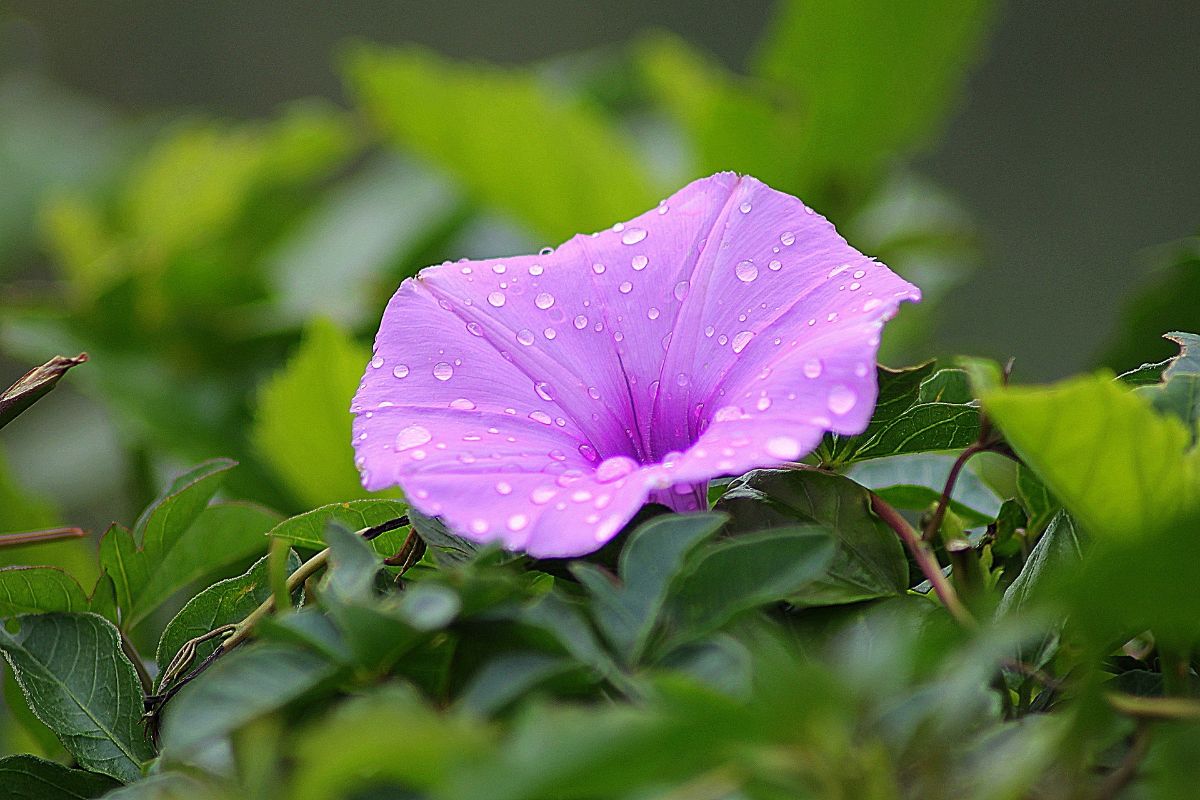
The Ipomoea it is the largest genus in the family of flowering plants Convolvulaceae, with more than 500 species, being a large and diverse group, with common names such as Gmorning loria or Campanite
It is originally from America and currently This genus of flowering plants is found in all tropical and subtropical regions of the world. The generic name is derived from the Greek words ips o ypos, which means "worm" or "creeper" and homoios, which means "resemblance," referring to their intertwined habit.
Characteristics of the Ipomoea

It includes annual and perennial herbaceous plants, lianas, shrubs and small trees; most species are climbing plants.
They have tall and long stems, when the weather is warm, the tips of the bush's branches bear clusters of funnel-shaped or tubular flowers, in colors ranging from purple to red, blue, white or yellow.
Most species of Ipomoea, they have spectacular and colorful flowers and are often grown as ornamental plants. Its flowers attract hummingbirds and long-tongued butterflies. It is a very fragile shrub, its lower stems become woody, but in frosty regions it usually dies down to the ground and rejuvenates rapidly in the spring.
Some species, such as Ipomoea batatas, have tuberous roots that are edible. The seeds of two varieties of bluebells, Ipomoea tricolor "Heavenly Blue" and "Pearly Gates", are listed by North Carolina State University as toxic.
The leaves are narrowly oval, with long sharp tips and are a main distinguishing feature to avoid confusion with noxious weed Ipomoea cairica, which has five-lobed leaves.
Some people use Ipomoea due to its high content of medical and psychoactive compounds, mainly alkaloids. Some species are famous for their properties in herbal and folk medicine, and other species are used as potent entrecogens.
What are the common names of the Ipomoea
Although its name is not too difficult to remember, the truth is that in many places the Ipomoea is not known as such. It has been given a more common name and it is by which you can know this plant.
Some of the names with which many refer to this are: bluebell, purple bells, morning glory. In English it is much more easily known as morning glory.
If you look closely, they really refer to its characteristics and it is a much easier name to remember than Ipomoea.
Care and cultivation of Ipomoea

Although adaptable to most conditions, Morning Glories, or Camapanillas, prefer a sunny position and plenty of water in the growing season. It should be planted in moderately fertile, well-drained soil.
You should water and fertilize the plant monthly during the growing season, but in winter, you should give in moderation.
These plants need a lot of space and should be reduced after flowering. Some climbing species may require support, as vines that fail to adhere to any type of support simply grow along the ground and can smother other plants.
In windy locations, shelter should be provided. This tropical shrub should be tied in spring to produce more branching. It will grow as a perennial herbaceous plant in temperate winter regions where frosts occur.
If the right conditions exist, these plants can be invasiveSome species grow so easily that they become weeds in some parts of the world.
If it is grown from seeds, you must first cut them with a sharp knife, scrape them lightly with sandpaper or nail file and then soak them in water for 24 hours before sowing at 18 ° C in spring.
Drain the seeds carefully on paper and plant them before they dry. covering them with half a centimeter of earth and separating them about 15 cm from each other.
The plants may be vulnerable to attack by various insect pests, such as aphids or aphids, caterpillars and ants. A strong stream from the hose knocks the aphids off the plant, so repeat this every two to three days until the pests are gone.
Plants infested with caterpillars or larvae can be treated with Bacillus thuringiensis powder and against ants you can use poisoned baits. Diseases such as white blisters, rust, fungal leaf spots, stem rot, thread blight, charcoal rot, and wilt can also appear, so pay close attention.
Potted Ipomoea Care
Although we have previously told you about the care of the ipomoea, when it is kept in a pot there are some aspects that you must also control so that this plant does not deteriorate or, worse still, get out of hand.
As for the location of the pot, you should place it in an area where receive several hours of direct sunlight. It is true that it tolerates sunlight well, but also being in semi-shade. You could put it in large pots, planters, etc. since they are the best for this plant (it needs a large and wide pot).
As for the land to use, it is not too demanding in this aspect, but it is convenient that, in case you want it to grow well, the have in a mixture of well-fertilized soil and drainage. In addition, as time goes by you will have to pay it so that it has more nutrients (it is a plant that requires a lot to grow).
Finally we would have irrigation. And although it is a plant that likes water, it can tolerate periods of drought. Of course, they cannot be very long because it would weaken the plant.
As we have said, the ipomoea is a plant that requires space to develop, and that implies two things:
- On the one hand, if you don't want it to invade parts or plants, you will have to control its growth. And that happens by pruning it often. It would be a maintenance pruning, so that it does not get out of the formation that you have made. But also to prevent it from affecting other plants.
- On the other hand, being in a pot will need you to change the soil often. In fact, it is possible that the roots will come out from the bottom in a matter of a short time, and you will have to put another large pot in it or directly end up planting it in the garden.
The fact that it is potted gives you a little more freedom in case the trellis or stake is unique. That is, have it only for the plant, and in its own pot. In this way, you will be able to move it easily (because it will not be subject to any fixed structure) and it will allow you to place it wherever you want.
How to use and/or where to put climbing bluebells

First of all we must remind you that the Ipomoea is a plant that is characterized by its invasive nature. In other words, if you plant it, you may have trouble eradicating it and it may try to "eat space" from other plants. In fact, some report that, even removing it from the root, it is easy for it to sprout again in other places because its seeds can fall in other places and get ahead even without care.
Therefore, if you are going to use it, You must take into account that invasion that it can cause if you do not control it well.
That said, are you wondering where to put the climbing bells? In general, this plant does not have much problem to get ahead and to climb where it can. But that also helps to cover the area of fences, wire mesh, house facades, etc.
We are talking about a plant very, very strong, fast growing and wide spread. At first, when it is small, it will need a stake or a lattice to be able to climb well, but once it is hooked to a safer area, such as a fence, it is likely that in a short time it will cover everything easily.
That said, there is no doubt that it could be put up to avoid prying eyes, or even to decorate the facade. Other options you have are to cover bars, form arches with them, or even for the railings themselves (covered with this plant).
Of course, when planting, if you are going to use several, you should not put them too close together, but better separated because when they spread they can harm each other.
How to sow ipomoea seeds
Do you dare to have ipomoeas in your house? If you get seeds (and we are already telling you that they are very easy to buy), there are some tips that we can give you to get them to germinate quickly.
One of the first is a practice that is often done with seeds and that we have already mentioned before. Is about introduce them for 24 hours in water. This will cause the seeds to swell because the water will get into them.
In some cases, you will notice that its "skin" is torn (you do not need to use a knife or sandpaper before doing this, most do it naturally) and even that it has an incipient white interior to germinate. Do not be surprised because they are very strong seeds that can germinate quickly. Now, that doesn't mean it's always going to be like this. They can take up to 15 days to activate, so if they don't in a few, keep trying.
Once you have the swollen seeds, you have to plant them. You may do it directly in the garden or in a pot. And what to do? The first thing to make sure they have a good soil with drainage and that it is loose. It does not make you insert the seeds too deep, just burying them a little will be enough. Of course, be very careful when watering, because if you leave them too shallow, with watering you can make them come out.
It is best not to give them the sun all day. If it can be, try to locate them in an area where they have morning or afternoon sun, but the rest to be kept in the shade. In this way, the rays will not burn the incipient shoots, which are the most delicate and are not yet used to it.
Hello. Thanks for the info.
I have them in a pot, so I would like to know what kind of fertilizer I should put on them.
I have also had problems with aphids. A year ago I had pink ipomeas but the aphids killed them.
Now I have one of the heavenly blue ones, although they have not yet given a flower and they have also been filled with aphids. I already treated them with "garlic water", and a special insecticide for them. I'll see how it comes out just with pressurized water.
Hello Emmanuel.
You can use any type of compost, organic for example. I usually recommend guano a lot, as it is very rich in nutrients and its effectiveness is very fast; Besides that it is natural (it is the waste of seabirds 🙂). But you can use any other as long as it is liquid if you have them in a pot.
The seaweed extract fertilizer is also very good, although it should not be abused as it is very alkaline.
Regarding aphids, you can treat them with potassium soap or diatomaceous earth.
Regards!
Hello, I have a glory vine from my mother, it was super flowered and very dense, suddenly it began to dry and now it is completely dry and it is beginning to fall on its own, but I see that the roots and stems are thick, they do not look bad but yes dry. What can I do? I understand that it regenerates itself but I'm not sure, please help me with your guidance. Thank you.
Hi Norma.
It will depend on the species: there are some that are seasonal and others live for several years. If yours has dried, then it is one of the first. Anyway, you can wait for spring to see if it sprouts again.
Greetings.
Hello
I wanted to ask, after how long after planting it does it bloom?
It doesn't take long: a few months (2, 3). All the best.
And if you use ladybugs as ecological control or some predator (natural enemy) ...
Without a doubt they are an excellent remedy for aphids 🙂
Hello, that vine seems malignant to me .. Weed never dies no matter how much one the court comes out again .. If the plague falls, it clears itself if the neighbor throws something at it to dry it .. It comes out again AND THOSE FLOWERS WHITE PEOPLE ATTRACT SOME LIKE HORRIBLE GIANT MOTHS, BLACK BUT ONLY AT NIGHT WHEN THEY ARE MORE OPEN I THINK THEY HAVE SPELLED MY Mum because she does not want to take her away for nothing in the world. Those night flying things are not from God!
What am I exaggerating? ♀️ they are not evil plants, they are resistant wild flowers, around here (Paraguay) they really come out like weeds, in the middle of people's farms or even where there is garbage. This is because birds and other animals inadvertently transport the seeds and since it is a plant that adapts to anywhere, it simply blooms. The same thing happens to vinca major. It is not even a plant that is used for spells or anything like that.
Those ugly black moths appear at night because they are in fact nocturnal animals. Insects appear where there are plants, if you don't like them, just throw insecticide on them and that's it. They are not from the devil anyway, they are just an ugly animal that does no greater harm than putting their cocoons in inappropriate places. Spray the house with any insecticide and that's it.
Hello Lara.
It is a fast growing plant, which in some regions of Spain has invasive potential, that is why we say that it "grows like a weed". But that does not mean that it is not pretty. It seems to me personally a great plant to cover lattices or arches.
Greetings and thanks for your comment.
It's been years since this comment but I can't stop laughing with "those night flying things are not from God" I have motephobia (phobia of moths) I had decided to put this plant in my gardener but after this comment I have to inform myself about the insects that this beautiful plant attracts. For me moths shouldn't exist, it's true that the poor ones don't do anything and they're not to blame for my phobia, but they're so annoying...
I have the blue and I just planted them in 5 pots but three seeds in each. I do not know if I did well. I have ferns next to it and money in other pots, my question is, I have seen that they are hallucinogenic and I have a 4-year-old girl, is there danger?